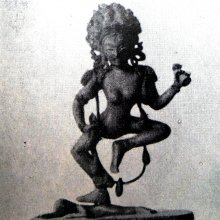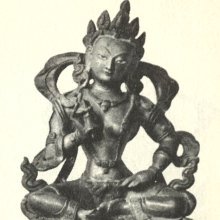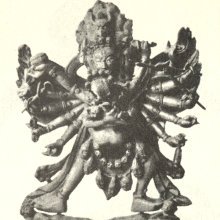Ghasmari, Ghasmarī: 3 definitions
Introduction:
Ghasmari means something in Buddhism, Pali, Hinduism, Sanskrit. If you want to know the exact meaning, history, etymology or English translation of this term then check out the descriptions on this page. Add your comment or reference to a book if you want to contribute to this summary article.
Images (photo gallery)
In Buddhism
Tibetan Buddhism (Vajrayana or tantric Buddhism)
Source: archive.org: The Indian Buddhist IconographyGhasmarī (घस्मरी) refers one of the eight Gaurīs, commonly depicted in Buddhist Iconography, and mentioned in the 11th-century Niṣpannayogāvalī of Mahāpaṇḍita Abhayākara.—Her Colour is green; her Symbol is the bell; she has two arms.—The fourth goddess in the Gaurī group is Ghasmarī.
Ghasmarī is described in the Niṣpannayogāvalī (pañcaḍāka-maṇḍala) as follows:—
Source: academia.edu: The Structure and Meanings of the Heruka Maṇḍala“Ghasmarī is green in colour and holds in her right hand the bell marked with a vajra”.
[The left shows the common gesture of tarjanī.
All the deities are violent in character with fearful appearance and ornaments, and garlands of heads. They dance in pratyālīḍha and show the raised index finger with clasped fist against the chest, as the common gesture.]
Ghasmarī (घस्मरी) is also mentioned as the Ḍākinī of the southern gate in the Jñānacakra, according to the 10th century Ḍākārṇava chapter 15. Accordingly, the jñānacakra refers to one of the three divisions of the saṃbhoga-puṭa (‘enjoyment layer’), situated in the Herukamaṇḍala. The four gate Ḍākinīs [viz., Ghasmarī] each has the same physical feature as the four Ḍākinīs starting with Lāmā.

Tibetan Buddhism includes schools such as Nyingma, Kadampa, Kagyu and Gelug. Their primary canon of literature is divided in two broad categories: The Kangyur, which consists of Buddha’s words, and the Tengyur, which includes commentaries from various sources. Esotericism and tantra techniques (vajrayāna) are collected indepently.
Languages of India and abroad
Sanskrit dictionary
Source: Cologne Digital Sanskrit Dictionaries: Edgerton Buddhist Hybrid Sanskrit DictionaryGhasmarī (घस्मरी).—name of a yoginī: Sādhanamālā 446.2.
Sanskrit, also spelled संस्कृतम् (saṃskṛtam), is an ancient language of India commonly seen as the grandmother of the Indo-European language family (even English!). Closely allied with Prakrit and Pali, Sanskrit is more exhaustive in both grammar and terms and has the most extensive collection of literature in the world, greatly surpassing its sister-languages Greek and Latin.
See also (Relevant definitions)
Full-text: Caturdevi, Konavasi, Vishuddhaheruka, Krodhishvari.
Relevant text
Search found 4 books and stories containing Ghasmari, Ghasmarī; (plurals include: Ghasmaris, Ghasmarīs). You can also click to the full overview containing English textual excerpts. Below are direct links for the most relevant articles:
The Indian Buddhist Iconography (by Benoytosh Bhattachacharyya)
Guhyagarbha Tantra (with Commentary) (by Gyurme Dorje)
Text 15.25 (Commentary) < [Chapter 15 (Text and Commentary)]
Text 16.3 (Commentary) < [Chapter 16 (Text and Commentary)]
Chapter 16 - Emanation of the Maṇḍala of Buddha-speech < [Chapter 16 (Text and Commentary)]
Cidgaganacandrika (study) (by S. Mahalakshmi)
Verse 231-234 [Smṛti Śakti and Nityasiddhā] < [Chapter 4 - Fourth Vimarśa]
Shakti and Shakta (by John Woodroffe)
Chapter XXVIII - Matam Rutra (the Right and Wrong Interpretation) < [Section 3 - Ritual]


